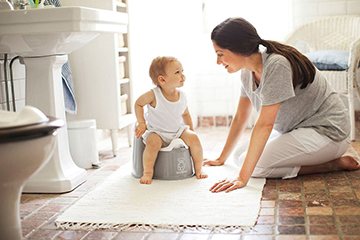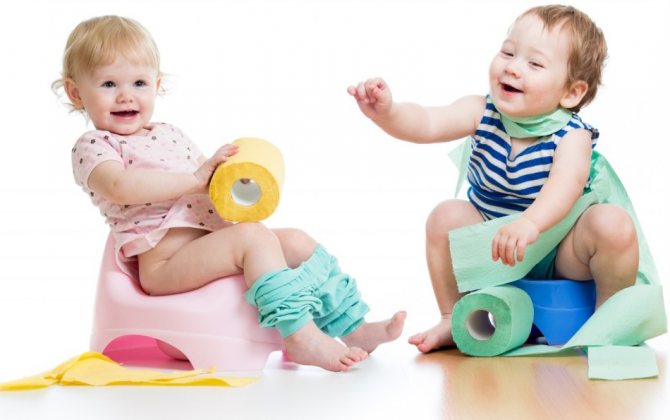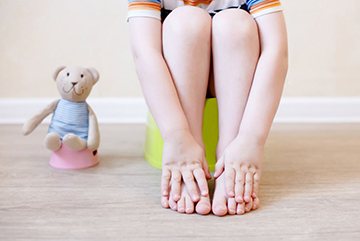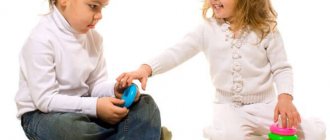As the baby gets older, parents increasingly think about potty training him.
It happens that adults do not show due patience and calmness in this delicate issue.
In this case, the training process drags on for many months, causing the child to cry and the parents to be upset.
Which pot to buy
Often parents buy a potty looking only at its appearance. However, when purchasing it, parents should pay attention to the following points:
- Models for boys and girls should be different. Models with a protrusion in front are suitable for boys, and round models are suitable for girls. When choosing, you need to focus on the anatomical features of your child.
- The material of the potty should be pleasant to the baby's delicate skin. It is better to give preference to a plastic model: enamel and ceramic ones are too cold to the touch. The plastic must be environmentally friendly and of good quality; it must not have burrs or cracks. The edges should not be very sharp, otherwise they will dig into the body.
- Some pediatricians advise purchasing white models. In them, parents can easily assess the color of urine and feces, and this will help prevent the development of certain diseases, such as jaundice.
- Don't rush to purchase models with additional features. A potty that makes different sounds or blinks with multi-colored lights, in the form of a throne or chair, in the form of a toy can distract the baby from the main goal.
- Pay attention to the stability of the pot you purchase. An unstable or sliding model on the floor will make the child feel insecure, and this will prevent him from quickly getting used to the new toilet.
- The presence of a backrest is not at all necessary, because they are taught to consciously go to the toilet at an age when the child can already sit well without support.
- The purchased model should not consist of a large number of parts. It is necessary to pay attention to the fact that it can be quickly disassembled, washed and easily dried.
- It would be good if the pot had a handle. It will come in handy when the baby wants to empty the contents into the toilet himself.
- In the store you can place your baby on the model you like. This way you will immediately see whether it is suitable in size and shape for the child. Give him the opportunity to choose the model he likes best. In this case, he will not consider the newly acquired item to be someone else’s.
The age at which you need to start accustoming your baby to a new “toilet” depends on his individual characteristics. Usually a child consciously sits on the potty at the age of one and a half to two years, when he already controls the excretory processes.
Basic rules - how to potty train a one-year-old child
To make the process of potty training a child as quick and painless as possible, it is important to follow a few simple rules:
- Before starting training, you need to show the baby a potty, introduce him to a new household item, give the child the opportunity to play with it (of course, the potty itself must be new and clean).
- With the help of soft toys or dolls, parents show the baby how to use the potty correctly, while explaining in words exactly why this item is needed.
- It is recommended to stop using disposable diapers during the daytime and replace them with panties. Diapers are best used during long walks and night sleep. When the baby wets his panties, parents should draw the baby’s attention to the fact that walking in wet panties is quite uncomfortable.
- It is necessary to put the baby on the potty at a certain time, for example, 20-30 minutes after feeding, after a walk, after sleep, at night.
- The child must constantly see the potty and be able to take it.
- Of course, at first everything will not always work out for the baby. You need to be patient and not scold the child.
Methodology: we train in 7 days

It was developed by teacher D. Ford for children who have reached the age of one and a half years.
At this age, children already understand the speech of adults, and can also take off their pants or panties themselves.
When implementing these recommendations, parents need to be persistent in their goals, but gentle in their demands.
On the first day, immediately after a night's sleep, remove the child's diaper, explaining that the baby has already grown up and should go to the toilet like adults. After these words, put him on the potty. It is important that he sits on it for at least 10 minutes. You can distract him at this time by giving him a toy, a book, or sitting next to him. If the baby refuses to sit, back off, and after a quarter of an hour, resume trying to introduce him to the potty. Repeat this procedure every time your baby usually goes to the toilet, such as before and after bedtime or immediately after eating.
the second day by reminding your baby that he is learning to go to the toilet like an adult. In the morning, put your child on the potty, and throughout the day remind him of the need to go to the toilet. Don’t forget to praise him solemnly, preferably in front of other family members. He must understand that his actions bring you joy.
On the third day , before going for a walk, do not put a diaper on your baby; before leaving the house, invite him to sit on the potty. If the weather is warm, you can use a collapsible (camping) potty while hanging out. Make sure your child remembers to go to the toilet throughout the day.
By the fourth day, the baby already knows what is required of him. Remind him to go potty when he's too busy playing. After each successful trip, joyfully praise your child.
For the rest of the week, remind your child about the potty from time to time and praise him for every successful trip to the toilet. The situation of success you create will help the baby quickly get used to new requirements.
If a child wets his pants, you shouldn’t scold him: this way you can discourage him from sitting on the potty for a long time. Don't show him your disappointment, even if your emotions overwhelm you.
Rules to help you quickly potty train
Make a game out of going to the potty. Show your child how to take the potty, take off his panties, and sit him on the potty. Then go with your child to take out the potty and wash it. You can do all your actions cheerfully and with a smile, then the child will definitely want to do everything himself.
Let us pay special attention to the requirements for the pot.
It is not at all necessary that it be very bright or play music. A potty is not a toy, but an object with a specific purpose. Do not let your child play with it, put it on his head, and so on. Offer it for one purpose only - pee and poop.
It’s better to make sure that the potty is comfortable and made from environmentally friendly materials. Moreover, you can train your child directly to the toilet, and not to the potty, if he has a special child seat. This point is not important, just be prepared to spend a lot of time in the toilet.
And now the main rules of potty training:
1 Remove diapers from your child's eyes and do not put them on your child for at least a day.
2Tell your child about the parts of the body, butt and genitals, what they are called and what they are needed for.
3 The diaper is also removed so that the child can see the process itself a couple of times and establish a connection between a full bladder and urination. How to sit on the potty can be demonstrated using toys or other children.
4The potty should be in the room, but not used for games.
5Seize the moment when the child becomes quiet and put him on the potty. At the same time, we need to explain why we sat down and what we will do. State what happened: “you peed” or “pooed.”
6In case of failure, do not scold the child. Gently remind him that things need to be done in the potty.
You cannot force a child to sit on the potty!
You can try to sit him down during some kind of game, that is, so that the action of “sit on the potty” is included in the game. If it works, praise it.
Many mothers ask different questions, but one of the main ones is: “When should I potty train my child?” This question can be interpreted in two ways. This is: “At what age should a child be potty trained?” or » At what time should I start potty training my baby?
Interesting! Diapers: pros and cons
Quick training method in 3 days
There are situations when you need to potty train your child urgently. This could be a vacation trip or going to kindergarten. In such cases, the three-day training method will help parents.

On the first day after waking up, remove your baby's diaper. Then put panties on him or even let him walk around the house naked.
As soon as he begins to empty his bowels, you need to substitute the potty without scaring him. It is necessary to ensure that a clear connection is formed in the child’s head between his actions and sitting on the potty.
On the second day, follow all the recommendations from the first day, adding a walk without diapers. Before leaving the house, encourage your child to go to the toilet.
On the third day, add another walk. Taking into account your baby's routine, remind him throughout the day to go to the toilet, for example, before and after bedtime, as well as before and after both walks.
There is no need to chase the child, scaring him. Explain to him what you are doing and why you want him to sit on the potty.
Is it too early?
It must be said that pediatricians have not yet come to a common opinion on whether it is worth trying to teach a baby to go potty at the age of 12 months. Everything here is determined individually.
Many children use the potty quite successfully at an earlier age. But this does not mean that they have any special abilities. It’s just that the baby’s reflex to emptying is triggered when disembarking. But at the same time, the baby is not yet able to fully control the urge to urinate and defecate.
Thus, the famous doctor Komarovsky believes that a conscious skill can be formed only by 18 months. But this does not mean that trying to potty train a child at the age of 1 year will be completely useless.
You can quickly and easily potty train a child whose bowel movements are regular and occur at approximately the same time. To do this, it will be enough to put the baby on the potty at a certain time (for example, after breakfast).
Pediatricians believe that you can start potty training your child if he:
Retraining
Sometimes a child who is already potty trained refuses to go. The reasons for the refusal may be the following:

- general malaise or painful teething;
- crisis of 1 year, expressed by stubbornness and uncontrollability;
- change of usual environment;
- the birth of a brother or sister;
- unstable emotional state of the baby's parents;
- fright during the last sitting on the potty.
In this case, it is necessary to give the baby time to return to its normal state. Then try again to teach your child consistently without putting too much pressure on him.
Sooner or later, the child needs to be weaned off diapers. How to teach a child to poop in a potty and why do children not want to go to the potty?
Teaching your baby to sit – read tips and tricks here.
Why can't girls be imprisoned early? You will find the answer to this question in the next publication.
Child on the potty: a clear example of how a brother or sister uses the potty

Naturally, in modern society it is not customary for mothers or fathers to relieve themselves in front of the child. Therefore, other children can become a good example.
IMPORTANT: When a child watches his older sister or brother use the potty, he instantly adopts this ritual. He repeats what others do.
This method is considered the easiest for parents and understandable for children.
Little tricks for potty training a child at 2 years old
For many decades, parents and psychologists have developed rules that will help young parents cope with solving a delicate problem:

- During training, put on your baby diapers in the form of panties or reusable panties with special inserts. This way, the baby will be able to try to take off his clothes, and if unsuccessful, they will remain dry.
- If possible, involve older children in the training process who can sit on the potty without any problems, setting a positive example. This way your baby will understand the naturalness of the processes of defecation and urination.
- If the child does not understand what is required of him, you can take a rubber toy, fill it with water and empty it over the potty. You definitely need to praise her for the result, ask the baby to praise the toy too. Then invite the baby to go to the toilet in the same way.
- Allow you to pour the contents of the potty into the toilet yourself if your baby expresses such a desire. If he can't do it well, allow him to press the toilet flush button. Talk about why you are cleaning the pot, why it became dirty.
- In parallel with training, the child should be introduced to the ritual of washing hands after defecation and urination. During this process, tell a story or sing a song about dirty hands that need to be washed. Such a relaxing moment after an important task will help evoke positive emotions in your baby.
Under no circumstances should you yell at your child if he doesn’t go to the potty. Read carefully how to teach your child to ask to use the potty using the gingerbread method.
You can see craft ideas for children 2-3 years old here.
Some parents place potties in every room. Psychologists do not recommend doing this: children must understand that they need to go to the toilet in a specially designated place.
Thus, before training, it is necessary to adequately assess the physiological readiness of the baby. After introducing a child to the potty, it is important for parents to sit him down regularly, gradually teaching him to take off his pants on his own. After each successful trip to the toilet, you need to actively praise the baby so that he continues to want to please his parents.











